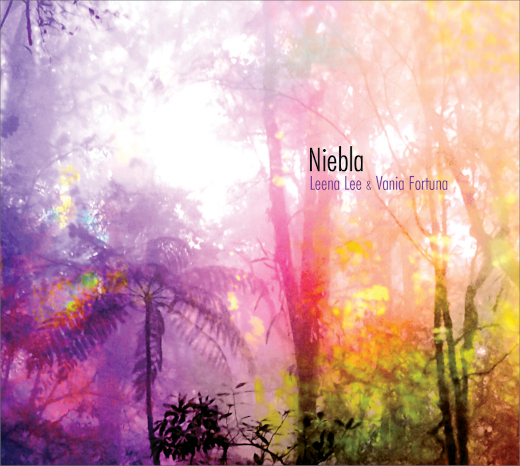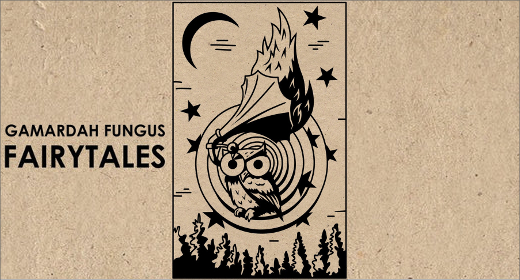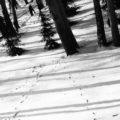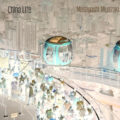Equipped by technology’s skins, eyes, ears, hands, and feet, we go where we have never been before, this immense territory marks these musical traditions as part of a wilderness never needing to be civilized. With this album one can sense whispers of the moral order of nature and the mythic notion of the heroic wilderness.

The cloud forest, and the Quetzal bird
The cloud forest is a magical place and this album, Niebla, permits a visit to listen to the home of the Quetzal bird to find imaginative relationships between distinct things that naturally coexist in these Central American landscapes. Niebla (Fog) is a collaborative project by Leena Lee & Vania Fortuna. The Quetzal is most vocal when there is plenty of mist at dawn and dusk and rarely call during very sunny or windy days. The human vocals, by Leena Lee & Vania Fortuna, blend with field recordings from El Triunfo Biosphere Reserve in the state of Chiapas; Sierra de las Minas Biosphere Reserve, in Guatemala; and from the Library of Bird Sounds of the Alfonso L. Zoology Museum. An abundance of my inspiration for this review of Niebla (besides the music itself) comes from my reading and listening to the work of and the philosophy of Canadian composer and sound ecologist Hildegard Westerkamp.
Lena Ortega (aka Leena Lee) is a sound artist, researcher, designer and teacher. Her line of research explores the intersections between natures/cultures. She is a member of the Art+Science research group at the National Autonomous University of Mexico (UNAM). She holds a Phd in Art History and a master’s degree in Visual Arts from the UNAM. She has done research and production residencies in Spain, Portugal, Germany, Italy and Finland. Has published articles in collective books on design and philosophy. Currently the host of the radio program: Surfaceless, The Skin is Not the Limit (Radio Nopal) a show dedicated to the active practice of listening which presents sound work, mostly done by women, in the fields of acoustic ecology and experimental music.
Sound from the reflection of the human voice ::
Vania Fortuna is a vocal artist dedicated to exploring sound from the reflection of the human voice as a social manifestation of emotion. As a Sociology graduate from National Autonomous University of Mexico (UNAM) she has developed Cultural Studies on international migration in Viadrina University (Germany). As a graduate of the Instituto Nacional de Bellas Artes of Mexico, she works mainly as a jazz performer, composer and musical director. In 2018 she served as a musical collaborator and vocal coach for the National Theater Company of Mexico. She has been a collaborator in the Research Lab on Art and Technology from the National Arts Centre (CENART) since 2020. Her research lines are: vocal improvisation, voice processing, sound art, sound experimentation, and Latin American music.
Quetzals, a sacred bird of the ancient Mayans and Aztecs, are found from southern Mexico to Bolivia. The name “quetzal” is from Nahuatl quetzalli, “long brilliant tail feather.” Quetzals are fairly large (over 32 cm or 13 inches long), slightly bigger than other trogon species, and feed on fruits, berries, insects and small vertebrates, such as frogs. The resplendent quetzal is the national bird of Guatemala because of its vibrant color, iridescent green or golden-green wing coverts, back, chest and head, with a red belly. They are largely solitary birds, strongly sexually dimorphic. Even with their famous bright plumage, they can be hard to see in their natural wooded habitats. Parts of the females’ plumage are brown or gray. By being educated about the world’s animal species we must realize how important it is to better care for them.
The Quetzal make soft, deep noises that can be very loud and they are known to use different calls depending on the situation, such as making whistle-like calls at dawn and dusk to stake a claim on its territory. The Quetzal has sometimes been referred to as The Rare Jewel Bird of the World, along with regularly being depicted in native art. The long, bright tail feathers of the males were also used in garments worn by royalty in particular. Today however, although the Quetzal is still a treasured species of many countries including both Guatemala and Costa Rica, their numbers are declining due to both Human interference in their natural habitats and the capture of them to be displayed in captivity, although few rarely survive in such conditions.
Cloud forests are one of the most successful habitats for the Quetzal, where the high moisture levels cause there to be a great deal of fog in the forest. Quetzals live in holes in the trees close to the top of the canopy that they have either built themselves using their powerful beaks, or ones that have been abandoned by Woodpeckers. The striking plumage of the Quetzal means that these birds are perfectly camouflaged amongst the abundance of vegetation surrounding them.
What you will hear are the sounds of the mountainous rainforests, also called mountain mesophilic forest. In the myths, the ancestors of the Mexica/Aztec came from a place in the north called Aztlan, the last of seven nahuatlacas (Nahuatl-speaking tribes, from tlaca, “man”) to make the journey southward, hence their name “Azteca.”
Something deep and alluring is localized ::
Equipped by technology’s skins, eyes, ears, hands, and feet, we go where we have never been before, this immense territory marks these musical traditions as part of a wilderness never needing to be civilized. With this album one can sense whispers of the moral order of nature and the mythic notion of the heroic wilderness. The first track, titled “Intro” (1:17) establishes our location in the cloud forest ecosystem. Next, the voices of our gifted artists, Leena Lee and Vania Fortuna, emerge from the mists and drizzle, weaving from the intersection of nature and culture, in personal, slow, intimate tones. “Gathering” (3:15) expands the environment, birds and voices swirling in the hidden canopy of the wilderness. “Calling” (3:39) continues this outreach, allowing the listener to recognize the source, and thus establish a sense of place and exploring forms which concern place, the echoed physical realization and discovering a new trail here today. Something deep and alluring is localized in terms of a specific place, and perceived as always belonging to that location.
Hearing the morning birds chirp with all their heart triggers joy and excitement in my soul. A morning breeze tours the jungle, making the flowers and leaves tango with rhythm and finesse. Soon new sounds emerge, more layered bird calls, wings fluttering, species have evolved their sounds to find open space in the audio ecosystem, which is why so many frequencies are occupied discovering an aesthetic musical language and the language of the recorded sounds and vocalized new soundscapes meet, like a traveler’s encounter with a new place.
The more complete and complex the soundscape, perhaps the healthier and more intact the ecosystem. This allows a composer to explore the sound’s musical/acoustic potential in depth, and to highlight the voices from those places that we do not usually hear, privileging the small, quiet and complex sounds: “Appearance” (4:21). This aural presentation of the natural sounds of the environment creates a sonic landscape in which the audience is composed of motionless listeners, who listen in from outside as the natural world sings its private song. Dusk stains the glistening foliage with shadow and murk.
These sounds invite a hybrid listening ::
Soundscape ecology is no longer in its infancy and clearly is set to bloom, just listen to the aptly named track “Rapture” (4:21). Two voices are heard establishing their rhythm in a chorus of wildlife. There is a pleasure in coming across uncontrived connections. This composed listening travels from shape to shape, and draws attention to aural similarities, it’s the nature of the essential meaning of these sounds that creates the real magic. These sounds invite a hybrid listening, to the ordinary made strange. I can somehow imagine the aroma of the vegetation of the whole jungle mixed all together and forms a rich smell that engulfs the breath. “Niebla” (3:21) establishes a sense of kinship with the animal and vegetable world. The haunting whistling sounds that close the final track leave us feeling that we are being called back and now forever haunted by such profound and amazing beauty. I hear something essential about the sounds, what they say is revealed through this subtle compositional alchemy. The journey itself becomes the point of balance, romantic-exploratory and reflective-pastoral, and permits a listening journey through the sounds of cloud forest birds and the canopy ecosystem. Consider that perhaps this temporary listening strangeness is a gift that is made of the authenticity of this uncharted, dangerous and exciting wilderness.
The image of known places as secure (and predictable) that asks about the influence of landscape, and unknown spaces as dangerous (and exciting) can somehow expose our senses, and lead to a feeling of entrapment in the known, as well as a longing for release into the unknown. Can you hear them? Uncertainty hangs in the warm, wet air as the creatures begin to prepare for the long stretch of darkness that returns. We occupy different places, simultaneously. Or are we listeners together—following the same trail? Have I invaded your space? Several things are taking place. A soundscape sensibility involves composing layers of listenings and relistenings, while staying quiet. For me the cloud forest, Niebla, is another place I like to visit.
Niebla is available on Flaming Pines March 25, 2022. [Bandcamp]



















![Hasbeen :: Bunker Symphonies II (Clean Error) — [concise]](https://igloomag.com/wp/wp-content/uploads/2025/04/hasbeen-bunker-symphonies-ii_feat-75x75.jpg)
![Extrawelt :: AE-13 (Adepta Editions) — [concise]](https://igloomag.com/wp/wp-content/uploads/2025/04/extrawelt-ae-13_v_feat-75x75.jpg)
![Beyond the Black Hole :: Protonic Flux EP (Nebleena) — [concise]](https://igloomag.com/wp/wp-content/uploads/2025/04/beyond-the-black-hole-protonic-flux_feat-75x75.jpg)
![H. Ruine, Mikhail Kireev :: Imagined / Awakenings (Mestnost) — [concise]](https://igloomag.com/wp/wp-content/uploads/2025/04/h-ruine-mikhail-kireev-imagined-awakenings_feat2-75x75.jpg)


![Squaric :: 808 [Remixes] (Diffuse Reality) — [concise]](https://igloomag.com/wp/wp-content/uploads/2025/04/squaric-808-remixes_feat-75x75.jpg)

